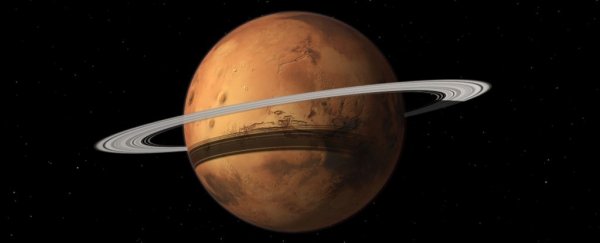If it's ringed planets you're after, our Solar System has only four: Jupiter, Saturn, Uranus, and Neptune – though in the future, we might get another one.
Mars is expected to join them one day as its moon Phobos eventually disintegrates into a halo of dust and boulders, but a new study suggests that both of Mars' moons could already be contributing a trail of dust to the Red Planet's future rings.
A team from India's Physical Research Laboratory has modelled the amount of dust expected to have been blasted from Mars' two moons by meteorites.
It's still something of a mystery as to where Mars' pair of rather lumpy, potato-shaped moons Phobos and Deimos came from, but scientists think they could have originated as captured asteroids, based on their density and reflectivity.
Regardless of their origins, the destiny of the larger and inner-most of the two could be literally set in stone – in a few tens of millions of years, the tidal pull of Mars' gravity might rip Phobos into rubble.
Right now, the moon's orbit decreases by 2 metres (6.5 feet) every century, which will see an eventual end to the satellite.
If Phobos is solid enough, the 22-kilometre (14-mile) wide body will crash into the dusty Martian surface in a rather spectacular apocalyptic swan song; if not, pieces of Phobos' rock and dust will be pulled into a long orbit around the planet as the moon fractures, eventually forming a ring.
While it doesn't currently have such a pretty feature, Mars does have its fair share of orbiting dust.
Evidence of a dispersed cloud of particles floating between 150 and 300 kilometres (93 to 190 miles) above the Martian surface was picked up by the Mars Atmosphere and Volatile Evolution (MAVEN) satellite in 2015, so the team wondered how much of it might be from the moons.
They compared the measurements made by MAVEN with models estimating the frequency of meteorites striking Mars and its two major satellites.
Arguing that lighter dust particles would be blown away by solar winds, they proposed those of a large enough size would fall into an orbit that trailed Phobos and Deimos.
They then concluded about 0.6 percent of the particles high above Mars had been shed from the two moons.
Over time, these larger particles themselves are expected to fall out of orbit. If Phobos is slowly losing weight thanks to the erosion of meteorite strikes, it would leave behind a slightly thinner ring, if and when it does eventually crumble.
Not that the team behind MAVEN are convinced.
According to New Scientist, MAVEN investigator Laila Andersson claimed there was no indication of an increase in dust in the orbits or vicinity of Phobos and Deimos.
"We still haven't seen a good indication that there is significant material in the vicinity of the moons. So I think it's a long shot," Anderssen told Rebecca Boyle at New Scientist. "But one should never say never."
While this doesn't rule out the possibility of a dust-trail following the moons, it does mean empirical evidence will have to wait for future missions that will allow us to study the exact nature of the super-thin veil of particles high over Mars and break down its origin.
It's often easy to overlook Mars' less attractive satellites as we go about exploring our neighbouring red planet. But we've only got about another 20 or so million years to study the larger of the duo. Best get cracking!
This research was published in Icarus.
